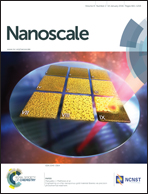A phenomenological model for selective growth of semiconducting single-walled carbon nanotubes based on catalyst deactivation†
Abstract
A method for the selective semiconducting single-walled carbon nanotube (SWCNT) growth over a continuous range from 67% to 98%, within the diameter range of 0.8–1.2 nm, by the use of a “catalyst conditioning process” prior to growth is reported. Continuous control revealed an inverse relationship between the selectivity and the yield as evidenced by a 1000-times difference in yield between the highest selectivity and non-selectivity. Further, these results show that the selectivity is highly sensitive to the presence of a precise concentration of oxidative and reductive gases (i.e. water and hydrogen), and the highest selectivity occurred along the border between the conditions suitable for high yield and no-growth. Through these results, a phenomenological model has been constructed to explain the inverse relationship between yield and selectivity based on catalyst deactivation. We believe our model to be general, as the fundamental mechanisms limiting selective semiconducting SWCNT growth are common to the previous reports of limited yield.


 Please wait while we load your content...
Please wait while we load your content...